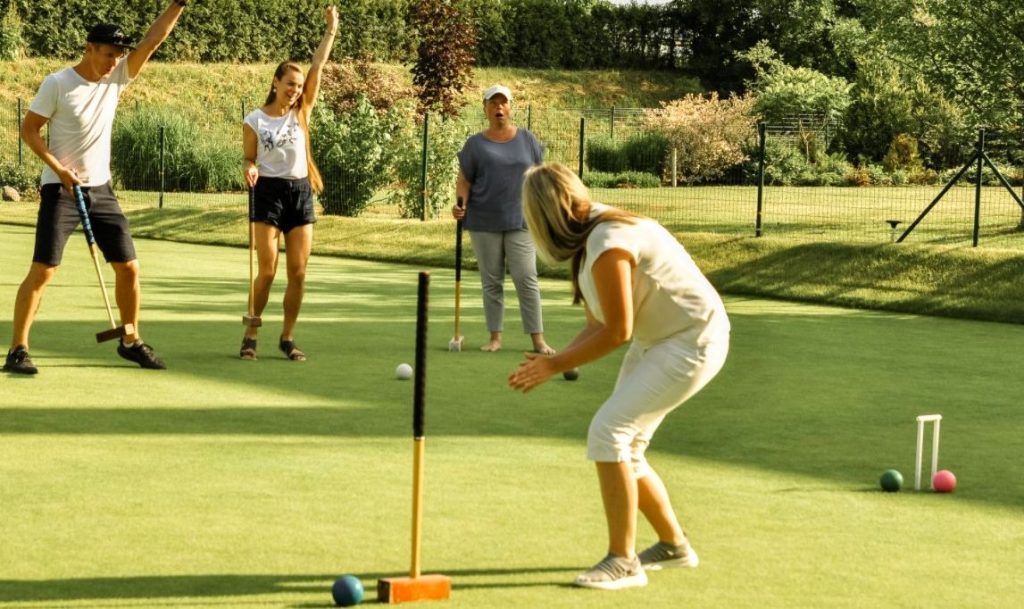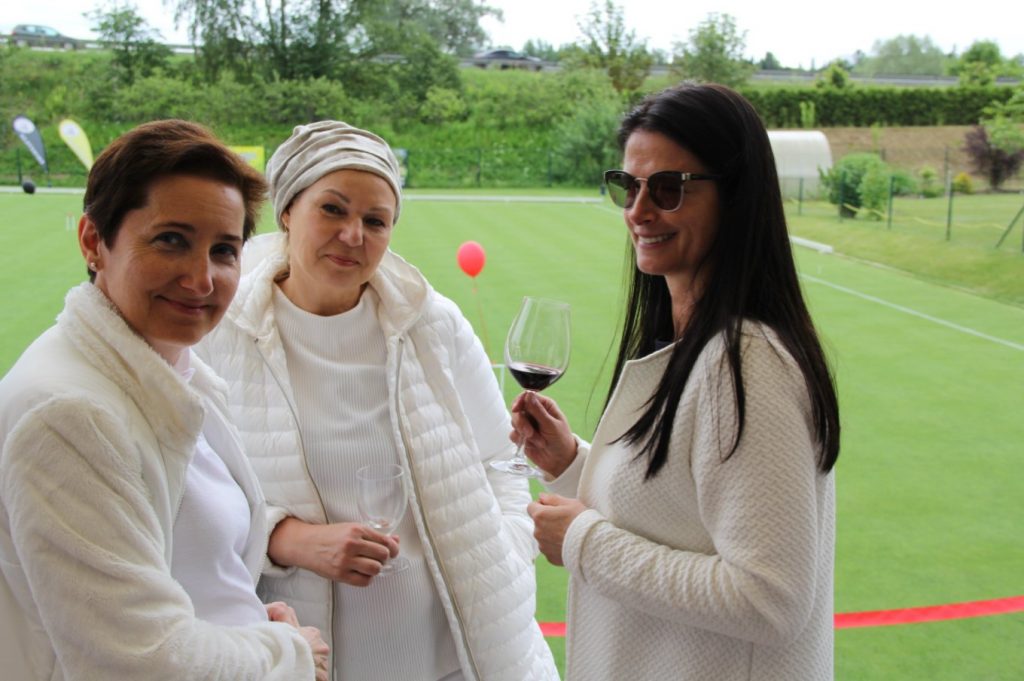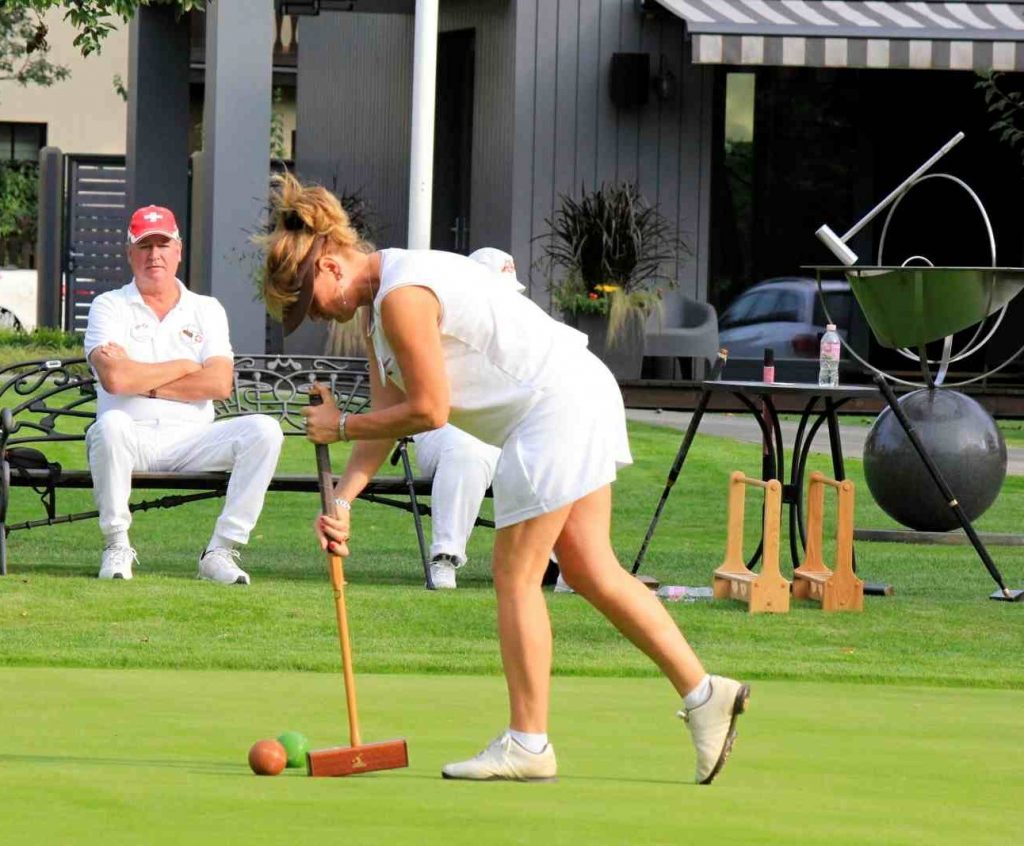Par Kroketu
Kādam tā ir izklaide, kādam turnīri un kādam socializēšanās. Viens no retajiem sporta veidiem, kur vecums un dzimums nespēlē lomu, lai viens ar otru sacenstos.
Kroketa laukums un inventārs
Kroketu iesācēju līmenī var spēlēt uz praktiski jebkura izmēra līdzena zāliena.
Sporta kroketa laukuma standarta izmērs ir 25,6 x 32 metri. Zālienam jābūt pilnīgi horizontālam un bez reljefa nelīdzenumiem. Kroketa laukums tiek apsēts ar īpašu zāliena sēklu maisījumu, kas ļauj zālienu pļaut 7-8 milimetru augstumā. Šāds pļaušanas augstums ir iespējams vienīgi ar golfa laukumiem paredzētajām profesionālām pļaujmašīnām ar cilindrisko asmeni.
Kroketa laukums un vārtiņu izvietojums:


Viena garuma vienība atbilst 7 jardiem jeb 6,4 metriem.
Kroketa bumbu standarta diametrs ir 92 milimetri un svars 452 grami. Iesācēju līmenim ražotāji piedāvā dažādas, tai skaitā arī nedaudz mazākas un vieglākas bumbas, tomēr Pasaules federācijas sertifikāts ir tikai divu modeļu bumbām: Dawson 2000 International un Sunshiny CB 16, kuras maksā attiecīgi apmēram 500 vai 300 euro par 4 bumbu komplektu.
Arī kroketa vārtiņu dizains un izmēri tiek stingri reglamentēti (skat. GC vai AC kroketa noteikumus sadaļā “kroketa noteikumi”). Atkarībā no turnīra līmeņa mainās noteiktais vārtiņu platums attiecībā pret bumbas diametru. Vārtiņu standarta platums ir bumbas diametrs + 3 milimetri. Augstākā līmeņa turnīros lieto vārtiņus ar platumu = bumbas diametrs + 0,8 milimetri.
Kroketa āmuri ir vismazāk reglamentētie no visiem inventāra elementiem. Tiek drīkst būt izgatavoti no dažādiem meteriāliem un dažādos izmēros. Āmura abām sitiena virsmām ir jābūt plakanām, identiskām un paralēlām. Spēlētāji parasti izvēlas āmura izmērus un svaru atkarībā no sava auguma, spēles stila un pieraduma. Iesācēju līmeņa āmrus var iegādāties 50-100 euro robežās, savukārt pasaules populārāko modeļu āmuri maksā apmēram 500 euro.
Padomi kroketa inventāra iegādei
Kā jau parasti mēdz būt, arī kroketa sporta inventāru ir iespējams iegādāties ļoti atšķirīgā kvalitātē un par ļoti dažādām cenām. Cenu amplitūda sākas no 10 EUR par komplektu rotaļlietu veikalā, kurš visticamāk kalpos tikai dažas dienas, un beidzas ar skaitļiem, kas rakstāmi ar 4 cipariem par komplektu, kurš ir piemērots starptautiskām sacensībām. Inventārs hobijam un amatieru sportam parasti ir nopērkams komplektā 4 vai 8 spēlētājiem.
Kroketa komplektā parasti ietilpst:
Profesionālo inventāru savukārt parasti pārdod pa daļām: atsevišķi vārtiņus, bumbas, āmuru kātus un āmuru galvas. Starp pasaules atzītākajiem kroketa inventāra ražotājiem kā piemēru var minēt:
https://www.jaqueslondon.co.uk/
No šiem ražotājiem ir iespējams iegādāties gan pilnus komplektus, gan arī atsevišķus inventāra elementus.
Komplekti iesācējiem ir pieejami arī caur šo interneta veikalu: www.ubergames.co.uk.
Pērkot kroketa komplektus caur interneta veikaliem, svarīgi ir pievērst uzmanību detaļām, kuras pārdevēji ne vienmēr uzsver: bumbu izmērs un svars, vārtiņu platums, vārtiņu kāta diametrs, āmura svars. Lētākā gala komplektiem šie parametri parasti neatbilst sacensību standartiem.
Pirms dārgāka inventāra iegādes vēlams vispirms to izmēģināt klātienē, palūdzot kādam
pieredzējušam spēlētājam.
Padomi kroketa laukuma iekārtošanā
Šeit ir saite uz weblapu, kurā atrodami dažādi raksti par laukumu izbūvi un iekārtošanu.
Ja Jums ir vēlēšanās izveidot savu kroketa laukumu, droši rakstiet vai zvaniet federācijas vai klubu vadītājiem, kuri labprāt Jūs konsultēs.
Kroketa vēsture
Zemāk iespējams iepazīties ar kroketa vēstures kopsavilkumu angļu valodā:
A Brief History of Croquet, according to Wikipedia
In the book Queen of Games: The History of Croquet[1] author Nicky Smith presents two theories of the origin of the game that took England by storm in the 1860s. The first is that the ancestral game was introduced to Britain from France during the reign of Charles II of England, and was played under the name of paille maille or pall mall, derived ultimately from Latin words for “ball and mallet“. This was the explanation given in the ninth edition of Encyclopaedia Britannica, dated 1877. Many writers have accepted this theory but there seems to be little evidence that the game either resembled croquet or influenced its rules; indeed, there is apparently a publication by one Dr Richard Prior dated 1872 that concludes that the two games are very different.
The second theory, which seems to have stronger credentials, is that croquet arrived from Ireland during the 1850s, perhaps after being brought there from Brittany where a similar game was played on the beaches. Records show the similar game of “crookey” being played at Castlebellingham in 1834, which was introduced to Galway in 1835 and played on the bishop’s palace garden, and in the same year to the genteel Dublin suburb of Dun Laoghaire (then Kingstown) where it was first spelt as “croquet”.[2]
John Jaques, of the manufacturer Jaques of London that still supplies a significant share of croquet equipment used today, apparently claimed in a letter to Arthur Lillie in 1873 that he had himself seen the game played in Ireland and, “I made the implements and published directions (such as they were) before Mr Spratt [who is also claimed to have first written down the rules] introduced the subject to me”. Whatever the truth of the matter, Jaques certainly played an important role in popularising the game, producing editions of the rules in 1857, 1860, and 1864.
Regardless when and by what route it reached the United Kingdom and the British colonies in its recognizable form, croquet is, like pall mall, trucco, jeu de mail and het kolven, clearly a derivative of ground billiards, which was popular in Western Europe back to at least the 14th century, with roots in classical antiquity.[3][4][5]
Croquet became highly popular as a social pastime in England during the 1860s; by 1867, Jaques had printed 65,000 copies of his Laws and Regulations of the game. It quickly spread to other Anglophile countries, including Australia, New Zealand, South Africa, the United States and Canada. No doubt one of the attractions was that the game could be played by both sexes; this also ensured a certain amount of adverse comment.
By the late 1870s, however, croquet had been eclipsed by another fashionable game, tennis, and many of the newly-created croquet clubs, including the All-England club at Wimbledon, converted some or all of their lawns into tennis courts. There was a revival in the 1890s, but from then onwards, croquet was always a minority sport, with national individual participation amounting to a few thousand players. The All England Lawn Tennis and Croquet Club still has a croquet lawn, but has not hosted any significant tournaments. The English headquarters for the game is now in Cheltenham.








Jautājumi?
Vēlies izmēģināt kroketu?
Sazinies ar mums!
